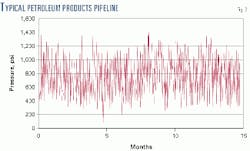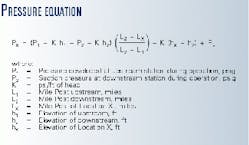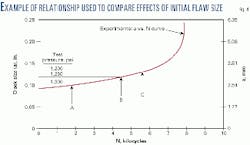HYDROSTATIC TESTING-Conclusion
Liquid pipeline service failures have occurred because of pressure-cycle-induced fatigue crack growth of defects.1 Our own familiarity with this phenomenon suggests that it may be more common than the public record reveals.
Such failures have also been prevented, however, by preemptive responses by pipeline operators worldwide.
This final of two articles on hydrostatic testing presents a technique that has assisted operators in addressing and controlling pressure-cycle-induced fatigue crack growth.
Part 1 of this series (OGJ, July 31, 2000, p. 54) presented findings related to the use of hydrostatic testing to verify pipeline integrity.
Crack growth
As constructed, pipelines may contain defects or imperfections from the pipe-manufacturing process, transit fatigue, or construction flaws. If severe, these defects will not survive the initial preservice hydrostatic test and will be eliminated.
If they are not severe enough to fail in the test, they will remain in the pipeline and may become enlarged by pressure-cycle-induced fatigue. This situation is illustrated schematically in Fig. 1a by the failure-pressure-vs.-crack-size relationship.
Fig. 1a shows that no flaw larger than aT can survive the initial test. The test establishes an initial safety margin because flaws must be larger than aT (as large as aS) to fail at the maximum operating pressure (MOP).
If a mechanism exists for flaws to grow in service, the margin will be eroded and, as shown in Fig. 1b, after a time (t1), an existing flaw of size aT may grow to a size aS. At that point, a service failure at the MOP becomes possible.
If this situation is anticipated, however, and if the rate of crack growth is predictable, a pipeline operator can make a timely intervention before the size aS is reached.
By conducting a current hydrostatic test, the operator can either remove those flaws that now have sizes larger than aT or at least prove that they do not exist. The maximum remaining defect size is then reset to aT.
Pressure cycles
Fig. 2 shows a typical 15-month service pressure spectrum for a liquid pipeline. Literally hundreds of large variations in pressure occur as various pumping schemes are used to meet shippers' requirements and take advantage of varying electric-power rates between daytime and nighttime.
Variations in pressure cause variations in hoop stress, and if a longitudinally oriented crack is present, the variation in stress can cause the crack to grow. An accompanying box presents the mathematically defined term "stress-intensity factor," which is the crack-driving force.
As "K" is proportional to S, DK is proportional to DS. In other words, fluctuating stress causes K to fluctuate, and a fluctuating K represents the factor that will cause a crack to grow.
Notice that K is a function of crack size "a" as well as a function of S. In fact, the log of the rate of crack growth, da/dN, has been shown to be proportional to the log DK (Fig. 3). This results in an equation for da/dN.
By solving for dN and integrating, one can predict the number of cycles required to grow the crack from an initial size aT established by a test to the size aS that will fail at the MOP.
This relationship is often called the "Paris" law after the person who first proposed it. It is a form of linear-elastic fracture mechanics.
Model
Crack-growth models can be used to evaluate the effect of pressure-cycle-induced growth on the possibly remaining flaws in a pipeline. One such model, referred to as RETEST,2 is based on linear-elastic fracture-mechanics (LEFM) principles and assumes that a family of "initial" defects is present in the pipe.
As a first step in a RETEST analysis, the user establishes the sizes of both the initial and the final defects. The initial defects (or cracks) are assumed to be the largest sizes that could barely survive at the hydrostatic test pressure. The final defects (or cracks) are assumed to be those that would fail at the maximum operating pressure (MOP).
The hydrostatic test pressure level, the pipe geometry (diameter and wall thickness), and the material properties, flow stress, and fracture toughness, are important parameters in this assessment. They determine the initial crack sizes that could survive the hydrostatic test and the final crack sizes that will fail at the MOP.
Since the number of defects of all possible sizes (length-and-depth combinations) that could survive the hydrostatic test is infinite, the analysis utilizes nine defect depths ranging from 10-90% through-the-wall thickness (in 10% increments).
The corresponding length for each of these nine defects is determined based on its depth, the hydrostatic test pressure, and the Charpy V-notch impact energy and flow stress. A mathematical model is used to calculate these sizes.3
The pressure-cycle data are used as the mechanism for fatigue-crack growth. The actual pressure data are rainflow-cycle counted.4 This procedure appropriately matches pressure pairs (peaks and valleys) for the pressure-cycle spectrum.
The pressure-cycle data (DPs) are applied to each of the nine defects defined above until the defect reaches the final size (calculated as explained above) that will fail in service. A linear-elastic model is used to calculate the applied stress-intensity-factor ranges (Ds) that cause the cracks to grow in response to the pressure cycles (DPs).5
This approach is suitable because the cracks grow in microscopic steps in an essentially elastic-strain regime in response to the cycles of pressure. The length of time (in years) to failure is then determined based on the representative time period of the pressure-cycle data.
For example, if the pressure-cycle data represent 1 month of operations and the analysis applies these same pressure data 18 times before the defect reaches a critical size, the fatigue life of the defect is 1.5 years (18 months).
The rate of crack growth induced by the pressure-cycle spectrum is modeled using the Paris Law equation:6
da over dN = C (DK)nwhere:a = Crack depthN = Number of pressure cyclesda over dN = Amount of crack growth per cycleK = Stress-intensity factor for a given pressure cycle.The constant (C) and the exponent (n) characterize the rate of fatigue-crack growth applicable to the particular material and environment of interest.PropertiesThe material properties (C and n) appropriate for the analysis are typically established on the basis of an actual fatigue-related leak in a pipeline. The constants are determined based on the apparent dimensions of the initial defect that has been observed to grow to failure after a certain number of years in service.The yield strength (YS) of the pipe material is used in the analysis to define a flow stress (FS) of the pipe material: YS + 10,000 psi.The fracture toughness of the material is approximated by an equivalent full-size Charpy V-notch impact energy. This value of toughness is based on the defect size and failure pressure level determined during the examination of the leak and on the apparent size of the flaw that caused the failure.Operating cyclesFor the typical pipeline to be analyzed, pressure data can be supplied in digital format for relevant pump stations. These pressure data can be acquired simultaneously at 15-min intervals for representative operating periods.To calculate pressures at intermediate points between each of the stations, we typically use a gradient factor of k = the specific gravity of the product times 0.433 to represent head loss. An average of the specific gravities of all products can be used.Accordingly, the pressure (PX) at any point between stations under flowing conditions is shown in the accompanying equation box. This method is used to determine the pressure cycles for all of the chosen locations between pump stations.Results









